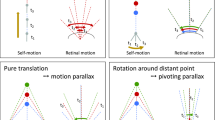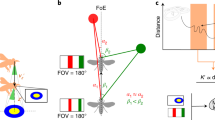Abstract
With their miniature brains many insect groups are able to control highly aerobatic flight maneuvers and to solve spatial vision tasks, such as avoiding collisions with stationary obstacles as well as moving objects, landing on environmental structures, pursuing rapidly moving animals, or localizing a previously learned inconspicuous goal on the basis of environmental cues. With regard to solving such tasks, these insects outperform man-made autonomous flying systems, especially if computational costs and energy efficiency are taken as benchmarks. To accomplish their extraordinary performance, several insect groups have been shown to actively shape the dynamics of the image flow on their eyes (“optic flow”) by the characteristic way they move when solving behavioral tasks. The neural processing of spatial information is greatly facilitated, for instance, by segregating the rotational from the translational optic flow component by way of a saccadic flight and gaze strategy. Flying insects acquire at least part of their strength as autonomous systems through active interactions with their environment, which lead to adaptive behavior in surroundings of a wide range of complexity. Model simulations and robotic implementations show that the smart biological mechanisms of motion computation and visually guided flight control might be helpful to find technical solutions.
Similar content being viewed by others
References
Borst A (2009) Drosophila’s view on insect vision. Curr Biol 19(1):R36
Borst A (2012) Fly motion vision: from optic flow to visual course control. e-Neuroforum 3(3):59–66
Borst A, Egelhaaf M (1989) Principles of visual motion detection. Trends Neurosci 12:297–306
Borst A, Egelhaaf M (1993) Detecting visual motion: theory and models. In: Miles FA, Wallman J (eds) Visual motion and its role in the stabilization of gaze. Elsevier, Amsterdam, pp 3–27
Borst A, Haag J (2002) Neural networks in the cockpit of the fly. J Comp Physiol A 188:419–437
Borst A, Haag J, Reiff DF (2010) Fly motion vision. Annu Rev Neurosci 33:49–70
Collett TS, Collett M (2002) Memory use in insect visual navigation. Nat Rev Neurosci 3:542–552
de Ruyter van Steveninck R, Bialek W (1995) Reliability and statistical efficiency of a blowfly movement-sensitive neuron. Phil Trans R Soc B Biol Sci 348:321–340
Dewell RB, Gabbiani F (2012) Escape behavior: linking neural computation to action. Curr Biol 22(5):R152
Dittmar L (2011) Static and dynamic snapshots for goal localization in insects? Commun Integr Biol 4:17–20
Eckert H (1980) Functional properties of the H1-neurone in the third optic ganglion of the blowfly, Phaenicia. J Comp Physiol 135:29–39
Egelhaaf M (2006) The neural computation of visual motion. In: Warrant E, Nilsson DE (eds) Invertebrate vision. Cambridge University Press, Cambridge, UK, pp 399–461
Egelhaaf M, Borst A (1993) Movement detection in arthropods. In: Miles FA, Wallman J (eds) Visual motion and its role in the stabilization of gaze. Elsevier, Amsterdam, pp 53–77
Egelhaaf M, Kern R (2002) Vision in flying insects. Curr Opin Neurobiol 12:699–706
Egelhaaf M, Kern R, Kurtz R, Krapp HG, Kretzberg J, Warzecha AK (2002) Neural encoding of behaviourally relevant motion information in the fly. Trends Neurosci 25:96–102
Egelhaaf M, Grewe J, Karmeier K, Kern R, Kurtz R, Warzecha AK (2005) Novel approaches to visual information processing in insects: case studies on neuronal computations in the blowfly. Assisted by Simon SA, Nicolelis MAL. In: Christensen TA (ed) Methods in insect sensory neuroscience. CRC Press LLC (Frontiers in Neuroscience), Boca Raton, pp 185–212
Egelhaaf M, Boeddeker N, Kern R, Lindemann JP (2012) Spatial vision in insects is facilitated by shaping the dynamics of visual input through behavioral action. Front Neural Circ 6:108
Floreano D, Zufferey JC, Srinivasan MV, Ellington C (2009) Flying insects and robots. Springer, Heidelberg
Fotowat H, Gabbiani F (2011) Collision detection as a model for sensory-motor integration. Annu Rev Neurosci 34(1):1–19
Frye MA (2010) Multisensory systems integration for high-performance motor control in flies. Curr Opin Neurobiol 20(3):347–352
Harrison RR, Fotowat H, Chan R, Kier RJ, Olberg R, Leonardo A, Gabbiani F (2011) Wireless neural/EMG telemetry systems for small freely moving animals. IEEE Trans Biomed Circ Syst 5(2):103–111
Hausen K (1984) The lobula-complex of the fly: structure, function and significance in visual behaviour. In: Ali MA (ed) Photoreception and vision in invertebrates. Plenum Press, New York, pp 523–559
Heeger DJ, Jepson AD (1992) Subspace methods for recovering rigid motion I: algorithm and implementation. Int J Comput Vis 7(2):95–117
Hengstenberg R (1993) Multisensory control in insect oculomotor systems. In: Miles FA, Wallman J (eds) Visual motion and its role in the stabilization of gaze, vol 1. Elsevier, Amsterdam, pp 285–298
Kern R, Boeddeker N, Dittmar L, Egelhaaf M (2012) Blowfly flight characteristics are shaped by environmental features and controlled by optic flow information. J Exp Biol 215:2501–2514
Krapp HG (2000) Neuronal matched filters for optic flow processing in flying insects. In: Lappe M (ed) Neuronal processing of optic flow. International review of neurobiology, vol 44. Academic (International Review of Neurobiology), San Diego, pp 93–120
Kurtz R (2012) Adaptive encoding of motion information in the fly visual system. In: Barth F, Humphrey J, Srinivasan MV (eds) Frontiers in sensing. Springer, Wien, pp 115–128
Land MF (1997) Visual acuity in insects. Annu Rev Entomol 42:147–177
Land MF (1999) Motion and vision: why animals move their eyes. J Comput Physiol A 185:341–352
Longuet-Higgins HC, Prazdny K (1980) The interpretation of a moving retinal image. Proc R Soc Lond Series B Biol Sci 208:385–397
Maimon G (2011) Modulation of visual physiology by behavioral state in monkeys, mice, and flies. Curr Opin Neurobiol 21(4):559–564
Nordström K (2012) Neural specializations for small target detection in insects. Curr Opin Neurobiol 22:272–278
Olberg RM (2011) Visual control of prey-capture flight in dragonflies. Curr Opin Neurobiol 22(2):267–271
Reichardt W (1961) Autocorrelation, a principle for the evaluation of sensory information by the central nervous system. In: Rosenblith WA (ed) Sensory communication. M.I.T. Press/Wiley, New York, pp 303–317
Srinivasan MV (2011) Honeybees as a model for the study of visually guided flight, navigation, and biologically inspired robotics. Physiol Rev 91(2):413–460
Srinivasan MV, Zhang S (2004) Visual motor computations in insects. Annu Rev Neurosci 27:679–696
Srinivasan MV, Zhang S, Altwein M, Tautz J (2000) Honeybee navigation: nature and calibration of the “odometer”. Science 287:851–853
Taylor GK, Krapp HG (2008) Sensory systems and flight stability: what do insects measure and why? Adv Insect Physiol Insect Mech Control 34:231–316
van Hateren JH, Kern R, Schwerdtfeger G, Egelhaaf M (2005) Function and coding in the blowfly H1 neuron during naturalistic optic flow. J Neurosci 25:4343–4352
Vardy A, Möller R (2005) Biologically plausible visual homing methods based on optical flow techniques. Connect Sci 17(1–2):47–89
Warzecha AK, Egelhaaf M (2001) Neuronal encoding of visual motion in real-time. In: Zanker JM, Zeil J (eds) Processing visual motion in the real world: a survey of computational, neural, and ecological constraints. Springer, Berlin, pp 239–277
Warzecha AK, Rosner R, Grewe J (2013) Impact and sources of neuronal variability in the fly’s motion vision pathway. J Physiol 107(1–2):26–40
Wolf H (2011) Odometry and insect navigation. J Exp Biol 214(10):1629–1641
Zeil J (2012) Visual homing: an insect perspective. Curr Opin Neurobiol 22:285–293
Zeil J, Boeddeker N, Hemmi JM (2008) Vision and the organization of behaviour. Curr Biol 18(8):R320
Zeil J, Boeddeker N, Stürzl W (2009) Visual homing in insects and robots. In: Floreano D, Zufferey JC, Srinivasan MV, Ellington CP (eds) Flying insects and robots. Springer, Heidelberg, pp 87–99
Author information
Authors and Affiliations
Corresponding author
Editor information
Editors and Affiliations
Rights and permissions
Copyright information
© 2013 Springer Science+Business Media New York
About this entry
Cite this entry
Egelhaaf, M. (2013). Visual Processing in Free Flight. In: Jaeger, D., Jung, R. (eds) Encyclopedia of Computational Neuroscience. Springer, New York, NY. https://doi.org/10.1007/978-1-4614-7320-6_343-15
Download citation
DOI: https://doi.org/10.1007/978-1-4614-7320-6_343-15
Received:
Accepted:
Published:
Publisher Name: Springer, New York, NY
Online ISBN: 978-1-4614-7320-6
eBook Packages: Springer Reference Biomedicine and Life SciencesReference Module Biomedical and Life Sciences
Publish with us
Chapter history
-
Latest
Visual Processing in Free Flight- Published:
- 25 October 2019
DOI: https://doi.org/10.1007/978-1-4614-7320-6_343-16
-
Original
Visual Processing in Free Flight- Published:
- 04 March 2014
DOI: https://doi.org/10.1007/978-1-4614-7320-6_343-15




